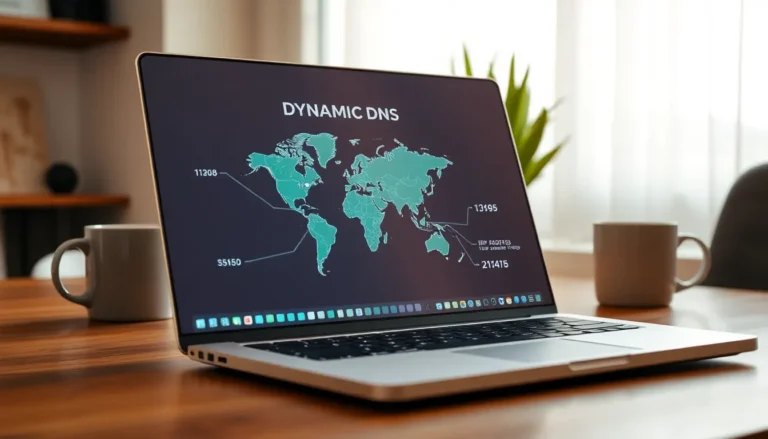Table of Contents
ToggleIn a world where a slow internet connection can feel like a personal affront, network troubleshooting takes center stage. Picture this: you’re in the middle of a crucial Zoom call, and suddenly, your screen freezes like it’s auditioning for a role in a horror movie. Panic sets in, but fear not! Network troubleshooting is here to save the day, armed with the power to restore your sanity and your connection.
From mysterious dropouts to the infamous “DNS server not responding,” network issues can turn everyday tasks into frustrating adventures. But with a little know-how and a dash of humor, anyone can tackle these tech gremlins. Whether you’re a seasoned IT pro or just someone trying to stream cat videos, understanding the basics of network troubleshooting can make all the difference. Dive in and discover how to turn those pesky problems into mere blips on your digital radar.
Understanding Network Troubleshooting
Network troubleshooting plays a crucial role in maintaining optimal performance for digital tasks. With many relying on stable internet connections, understanding how to resolve common issues enhances the online experience.
Importance of Network Troubleshooting
Network troubleshooting proves essential for minimizing downtime and improving productivity. By quickly diagnosing errors, users can tackle issues like slow speeds or connectivity interruptions. Knowledge in troubleshooting methods empowers individuals to fix problems without needing extensive technical support. A better grasp of network principles aids in preventing future disruptions, significantly enhancing overall user satisfaction. Skills in this area facilitate smoother operations during critical tasks, making network troubleshooting an invaluable asset in daily digital interactions.
Common Network Issues
Frequent network issues vary from slow connections to complete outages. Users might experience dropped connections, which disrupts tasks and can cause frustration. DNS errors often lead to problems accessing websites, confusing many individuals. Additionally, IP conflicts may arise when two devices attempt to use the same address, causing further inconvenience. Hardware malfunctions, such as router failures, also contribute to network complications. Recognizing these common issues allows users to implement quick fixes, restoring efficient connectivity and enhancing their online experiences.
Tools for Network Troubleshooting

Network troubleshooting relies on an array of effective tools. Specific software and hardware options provide comprehensive support for diagnosing and resolving various issues.
Software Tools
Network monitoring software detects connections, analyzes traffic, and identifies potential problems. Tools like Wireshark capture and examine packets for in-depth analysis. Additionally, Ping and Traceroute utilities diagnose connectivity issues by checking response times and routing paths. Firewalls protect networks while tools such as SolarWinds simplify the management of network performance. Moreover, these applications offer real-time feedback, enhancing overall troubleshooting effectiveness.
Hardware Tools
Hardware tools play a vital role in identifying physical network issues. Network analyzers assess the network’s performance and measure connection quality. Devices such as cable testers ensure cable integrity, preventing disruptions caused by faulty wiring. Routers also serve as essential hardware components, as they direct traffic and manage IP addresses. In addition, handheld network testers streamline the process by providing portable solutions for on-site troubleshooting. Each tool contributes to an efficient and reliable troubleshooting process.
Troubleshooting Methodologies
Network troubleshooting methods vary in approach but share common goals: to identify and resolve issues efficiently. Two effective methodologies include the layered approach and the top-down approach, both offering unique benefits for diagnosing network problems.
Layered Approach
The layered approach focuses on analyzing networks according to the OSI model. Troubleshooters start at a specific layer, assessing physical connections, data link issues, and up to application layer problems. This method allows for a systematic evaluation, making it easier to pinpoint the source of issues. For example, if a user encounters issues at the application layer, the problem could stem from higher-level protocols. Alternatively, diagnosing physical connection issues engages layers one and two. The layered approach promotes efficiency, as isolating problems minimizes time spent on unnecessary checks.
Top-Down Approach
The top-down approach emphasizes starting from the application layer and working downward. Diagnosticians first evaluate user experience and application performance before analyzing lower layers. For instance, if an application shows slowness, the first step focuses on software factors rather than infrastructure. Following this, the troubleshooting moves down to examine network configurations, routing protocols, and physical connections. This method is particularly useful in organizations where applications have direct impacts on business performance. Through this approach, teams can quickly identify factors affecting user experience before delving into deeper infrastructural issues.
Best Practices for Effective Troubleshooting
Effective troubleshooting relies on organized practices that enhance efficiency and accuracy. Two critical components are documentation and monitoring.
Documentation
Thorough documentation serves as a crucial reference throughout the troubleshooting process. It’s helpful to maintain records of previous issues, solutions, and network configurations. Using detailed logs allows for quick access to historical data, streamlining future troubleshooting. Creating a checklist can ensure all potential problem areas are considered. Regular updates to documentation foster clear communication among team members, minimizing repeated efforts. Establishing a centralized repository for documents enhances accessibility, making it easier for everyone involved to understand network history and changes.
Monitoring and Logging
Proactive network monitoring aids in identifying potential issues before they become significant problems. Utilizing network monitoring tools enables real-time analysis of traffic patterns and performance metrics. These tools can notify administrators about anomalies or performance dips, allowing for prompt intervention. Logging essential events and metrics provides a comprehensive view of network health over time. Collecting data on usage trends helps spot recurring problems and adjust resources accordingly. An organized log creates a timeline that assists in root cause analysis, enhancing the understanding of network dynamics and improving future responses.
Mastering network troubleshooting is essential for anyone navigating today’s digital landscape. By equipping themselves with the right tools and methodologies, users can tackle common issues effectively. Understanding both software and hardware options ensures that individuals can address a wide range of connectivity problems.
Emphasizing best practices like thorough documentation and proactive monitoring further enhances troubleshooting efficiency. By fostering a culture of awareness and preparedness, users can minimize disruptions and maintain a seamless online experience. Ultimately, empowering oneself with troubleshooting skills leads to a more reliable and productive digital environment.







